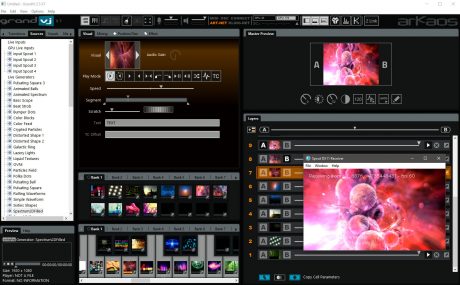
EUROPE – ArKaos launches GrandVJ 2.5 – a brand new version of its hugely popular GrandVJ software designed for fast intuitive control of video sources by VJs, and video operators working in all ‘live’ scenarios – from concerts to festivals to clubs.
More details from Arkaos (www.arkaospro.com):
Good video and media visuals are integral and vital to the visuality of most events and entertainment environments – from corporate presentations and parties to the largest concerts and festival performances.
ArKaos’s core philosophy has always been to ensure that users and fans of the platform have the most flexible and powerful tools to create potentially spectacular shows. Right at their fingertips.
The launch of GrandVJ v2.5 follows intensive research and development from the ArKaos team, wizards of creative video, and has been comprehensively tested and approved by a number of ArKaos aficionados and enthusiasts.
Says ArKaos’ Managing Director, Agnes Wojewoda, “We have listened extensively to what our VJ and video operator community has been requesting and taken that valuable feedback and their wish-lists on-board in developing this version of GrandVJ”.
GrandVJ 2.5 takes this concept to another level with a host of new features on the platform including:
- Spout output in both Instant and VideoMapper modes: Using Spout allows GrandVJ to integrate and share both inputs and outputs in real-time with a large number of other applications.
- DMX Merger in the LEDMapper with GrandVJ XT: Allows a VJ / operator to interact with a lighting designer and merge the generated video content with controls such as pan and tilt which are created by a lighting console. In the reverse direction, it enables the LD to apply effect like strobe over the content being displayed / created by the VJ.
- Support for complex DMX fixtures like moving heads: Enabling users to easily and creatively include pixel-based moving light fixtures in their shows.
- Improved Art-Poll based node discovery in the LEDMapper: Makes it easier to identify fixtures that are available on the network.
- Auto-unicast for easier and optimized Art-Net network setup: Using unicast (one sender, one receiver) rather than broadcast puts less pressure on all fixtures that are available on the network.
- Support for Draft Devices in the Kling-Net Mapper to prepare shows offline: Shows with multiple fixtures can be prepped in advance, a great advantage for challenging timeframes!
- All applications run in 64 bits: for speed, minimal latency and seamless realtime operation.
GrandVJ 2.5 will also help optimize functionality of the host of pixel-based LED fixtures and media products constantly coming on to the market, as well as for existing ‘conventional’ video surfaces like LED and projection screens.
There is improved support for DPI display scaling and for international characters, as well as faster movie playback for ProRes on Mac and Windows and more rapid YUV color conversion for all Mac codecs.
The v2.5 LED Mapper now has the facility to merge the Art-Net input with the LEDMapper output, and an Editor has been added to create fixtures with any format of DMX pixel-mapping including channel gaps.
DMX Merger in the LEDMapper ultimately enables LDs and VJs to work more harmoniously and creatively together in one mutually coherent visual space filled with a fusion of potentially shared and treated effects.
The setting of constant values for some DMX fixture channels is now possible and there is a new option for automatic Unicast through ArtPollReply discovery. UI and MIDI control functions set the blending mode and intensity of the DMX Merger, and the whole mapping of file operations with Import, Export and Save is clearer and more concise.
The upgraded Spout version 2.006 offers increased texture sharing compatibility.
With all v2.5 applications now in 64 bits – as Apple does not provide 64-bit QuickTime – GrandVJ now uses FFmpeg to read all QuickTime codecs. There is no longer any need to install QuickTime on Windows (like previous versions of GrandVJ where QuickTime was used to play ProRes encoded videos).
GrandVJ automatically sends output through spout video frame sharing, but the application will now only perform a transfer if a Spout receiver is listening.
For full specifications, please check:
http://vj-dj.arkaos.net/grandvj/about


